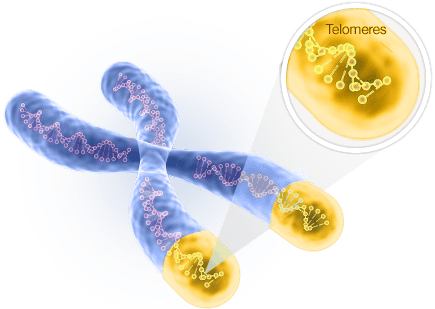hTERT
Human Telomerase Reverse Transcriptase
Telomerase reverse transcriptase, abreviated to TERT or hTERT in humans is a large ribonucleoprotein complex with reverse transcriptase activity.
hTERT and Telomeres

The TERT gene encodes the instructions required to make part of the telomerase enzyme, with this enzyme crucial for maintaining the telomeres found located on the ends of Chromosomes. Telomeres are vital for the protection of the entire genome as they help prevent chromosomes from abnormally sticking together or degrading. Naturally, when a cell undergoes DNA replication and cell division the telomeres are gradually shortened. Once the chromosomes have undergone a number of replication cycles and the telomeres have shortened to a critical level, subsequent cell division is halted. The telomeres fuse and apoptosis of the cell is triggered. This can be considered an inbuilt safety mechanism helping to prevent abnormal DNA replication and cell division from occurring. Without this, abnormal cells could continue to be replicated which may alter their behaviour within the body.
 |
The telomerase enzyme therefore plays a central role in the maintenance of the telomeres. Each time the cell undergoes replication the enzyme works to counteract the shortening of the telomeres by adding small repeated segments of DNA. The amount of telomerase detected within a cell reflects how actively the cell line divides. Rapidly dividing cells such as cells that line the lungs, GI tract and within the bone marrow will have a greater level of telomerase. Whilst for slower dividing cell lines, which is the case for the majority of cells, telomerase will be undetected or found at very low levels.
Another gene that contributes to the TERT enzyme is TERC, this gene encodes for the hTR component of the enzyme. The hTR component has an inbuilt RNA template, responsible for making the repeated sequences of DNA. The TERT component is then responsible for the addition of these segments to the 3' end of the linear chromosome. It is understood that telomeres can reach a length of 15,000 base pairs, with around 25-200 base pairs lost each time a cell divides. When low levels of telomerase are present greater erosion of the chromosome will occur as the telomeres are unable to be maintained. This process is most common in somatic cells where cellular ageing is routine. When telomerase is activated the cell will continue to grow and divide, these characteristics are often present in cancerous tissues where high levels of telomerase have been detected. In some cases levels of telomerase have been detected to be 10-20 times higher than normal body cells. In addition to this 90% of cancerous cells have been found to have enhanced telomerase activity.
Studying hTERT Activity
Understanding how telomerase activity can be controlled or turned off and on could help to provide an insight into how cancerous cells develop. If telomerase activity could be manipulated and turned off in the early stages of cancer, the telomeres would shorten and cell death would occur. This would help prevent cancerous cells from developing any further. Alternatively, if the tumour has already developed telomerase activity could be inhibited once the tumour has been removed helping to prevent relapse.

Abbexa's unique TERT products have been shown to provide accurate analysis of TERT (published here). The hTERT antibody has been shown to work exceptionally well for immunoprecipitation of hTERT using beads. Additionally, the relevant immunogen is available for purchase, and the antibody and antigen can be obtained together as a hTERT kit. To further support studies into the cell cycle, apoptosis, ageing and cancer, a HEK-293T Telomerase Over-Expressing Cell Line has been produced. This differs from other commercially over-expressing cell lines, because it over-expresses all three required components of the enzyme complex: hTERT, hTR, and dyskerin. This is the only way to obtain a several-hundred fold increase in enzymatic activity.

